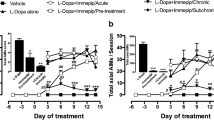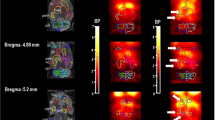Abstract
Rats with unilateral 6-hydroxydopamine (6-OHDA)-induced lesions of the ascending nigro-striatal pathway have been shown to rotate in response to dopamine (DA) agonists that are not considered to have postsynaptic DA stimulant properties in intact animals, suggesting a relative loss of DA receptor selectivity in the denervated striatum. The present experiments assessed the possibility that this loss of selectivity may extend to serotonin (5HT) agonist drugs. The 5HT-1a agonist 8-hydroxy-2-(di-n-propylamino)tetralin (8-OH-DPAT), at doses of 0.3–3 mg/kg SC, induced robust contralateral rotational behavior (RB) in 6-OHDA-lesioned rats that had been preselected on the basis of high responsiveness to the atypical DA agonists 3-PPP and SKF 38393. Rats with unilateral dorsal raphe lesions induced by 5,7-dihydroxytryptamine (5,7-DHT) showed contralateral RB in response to similar doses of 8-OH-DPAT but with a different behavioral pattern. The putative 5HT-1b agonist RU 24969 produced contralateral RB in 5,7-DHT-lesioned rats while showing a much weaker effect in 6-OHDA-lesioned rats. Striatal DA levels were depleted by 99% in representative 6-OHDA-lesioned rats but striatal 5HT levels were unaffected. The effects of 8-OH-DPAT in 6-OHDA-lesioned rats were therefore not attributable to destruction of ascending 5HT-containing neurons. These effects may result from indirect actions, mediated by 5-HT neurons or neuronal receptors, that result from asymmetry of brain DA systems. Alternatively, it is proposed that rats with highly denervated striatal DA receptors show a loss of apparent molecular selectivity such that weak partial DA agonist properties of 8-OH-DPAT, although not demonstrable in normal rats, become manifested under these conditions.
Similar content being viewed by others
References
Baldessarini RJ, Amatruda TT, Griffith FF, Gerson S (1975) Differential effects of serotonin on turning and stereotypy induced by apomorphine. Brain Res 93:158–163
Berger TW, Kaul S, Stricker EM, Zigmond MJ (1985) Hyperinnervation of the striatum by dorsal raphe afferents after dopaminedepleting brain lesions in neonatal rats. Brain Res 336:354–358
Blackburn TP, Foster GA, Heapy CG, Kemp JD (1980) Unilateral 5,7-dihydroxytryptamine lesions of the dorsal raphe nucleus (DRN) and rat rotational behavior. Eur J Pharmacol 67:427–438
Blackburn TP, Kemp JD, Martin DA, Cox B (1984) Evidence that 5-HT agonist-induced rotational behaviour in the rat is mediated via 5-HT1 receptors. Psychopharmacology 83:163–185
Buonamici M, Caccia C, Carpentieri M, Pegrassi L, Rossi AC, DiChiara G (1986) D-1 receptor supersensitivity in the rat striatum after unilateral 6-hydroxydopamine lesions. Eur J Pharmacol 126:347–348
Conrad LCA, Leonard CM, Pfaff DW (1974) Connections of the medial and dorsal raphe nuclei in the rat: an autoradiographic and degeneration study. J Comp Neurol 156:179–205
Costall B, Naylor RJ, Pycock C (1976) Non-specific supersensitivity of striatal dopamine receptors after 6-hydroxydopamine lesion of the nigrostriatal pathway. Eur J Pharmacol 35:275–283
Creese I, Snyder SH (1979) Nigrostriatal lesions enhance striatal 3H-apomorphine and 3H-spiroperidol binding. Eur J Pharmacol 56:277–281
Creese I, Burt DR, Snyder SH (1977) Dopamine receptor binding enhancement accompanies lesion-induced behavioral supersensitivity. Science 197:596–598
Dray A, Davies J, Oakley NR, Tongroach P, Vellucci S (1978) The dorsal and medial raphe projections to the substantia nigra in the rat: electrophysiological, biochemical and behavioral observations. Brain Res 151:431–442
Fenton HF, Leszczak E, Gerhardt S, Liebman JM (1984) Evidence for heterogeneous rotational responsiveness to apomorphine, 3-PPP and SKF 38393 in 6-hydroxydopamine-denervated rats. Eur J Pharmacol 106:363–373
Hefti F, Melamed E, Wurtman RE (1980) Partial lesions of the dopamine nigrostriatal system in rat brain. Brain Res 195:123–137
Hjorth S, Carlsson A, Lindberg P, Sanchez D, Wikstrom H, Arvidsson LE, Hacksell V, Nilsson JLG (1982) 8-Hydroxy-2-(di-n-propylamino)tetralin, (8-OH-DPAT), a potent and selective simplified ergot congener with central 5-HT-receptor stimulating activity. J Neural Transm 55:169–188
Hunt P, Oberlander C (1981) The interaction of indole derivatives with the serotonin receptor and non-dopaminergic circling behavior. Adv Exp Med Biol 133:547–561
Jacobs BL (1976) An animal behavior model for studying central serotonergic synapses. Life Sci 19:777–786
Konig JFR, Klippel RA (1963) The rat brain. Williams and Wilkins, Baltimore, MD
Marshall JF, Ungerstedt U (1977) Supersensitivity to apomorphine following destruction of the ascending dopamine neurons: quantification using the rotational model. Eur J Pharmacol 41:361–367
Middlemiss DN, Fozard JR (1983) 8-Hydroxy-2-(di-n-propylamino)-tetralin discriminates between subtypes of the 5HT1 recognition site. Eur J Pharmacol 90:151–153
Miller RG Jr (1981) Simultaneous statistical inference. Springer, Berlin Heidelberg New York
Milson JA, Pycock CJ (1976) Effects of drugs acting on cerebral 5-hydroxytryptamine mechanisms on dopamine-dependent turning behavior in mice. Br J Pharmacol 56:77–85
Nagy JI, Lee T, Seeman P, Fibiger HC (1978) Direct evidence for pre- and post-synaptic dopamine receptors in Brain. Nature 274:278–281
Paxinos G, Watson C (1982) The rat brain in stereoaxic coordinates. Academic Press, Australia
Reinhard JF Jr, Roth RH (1982) Noradrenergic modulation of serotonin synthesis and metabolism. I. Inhibition by clonidine in vivo. J Pharmacol Exp Ther 221:541–546
Setler PE, Sarau HM, Zirkle CL, Saunders HL (1978) The central effects of a novel dopamine agonist. Eur J Pharmacol 50:419–430
Seyfried CA, Fuxe K, Wolf HP, Agnati LF (1982) Demonstration of a new type of dopamine receptor agonist: an indolyl-3-butylamine. Actions at intact versus supersensitive dopamine receptors in the rat forebrain. Acta Physiol Scand 116:465–468
Sills MA, Wolfe BB, Frazer A (1984) Determination of selective and nonselective compounds for the 5-HT1a and 5-HT1b receptor subtypes in rat frontal cortex. J Pharmacol Exp Ther 231:480–487
Silverman PB, Ho TB (1981) Persistent behavioural effect of apomorphine in 6-hydroxydopamine-lesioned rats. Nature 294:475–477
Smith LM, Peroutka SJ (1986) Differential effects of 5-hydroxy-tryptamine-la selective drugs on the 5-HT behavioral syndrome. Pharmacol Biochem Behav 24:1513–1519
Ungerstedt U, Arbuthnott GW (1970) Quantitative recording of rotational behavior in rats after 6-hydroxydopamine lesions of the nigrostriatal dopamine system. Brain Res 24:485–493
Van der Kooy D, Hattori T (1980) Bilaterally situated dorsal raphe cell bodies have only unilateral forebrain projections in the rat. Brain Res 192:550–554
Author information
Authors and Affiliations
Additional information
Offprint requests to: J.M. Liebman
Rights and permissions
About this article
Cite this article
Gerber, R., Altar, C.A. & Liebman, J.M. Rotational behavior induced by 8-hydroxy-DPAT, a putative 5HT-1A agonist, in 6-hydroxydopamine-lesioned rats. Psychopharmacology 94, 178–182 (1988). https://doi.org/10.1007/BF00176841
Received:
Revised:
Issue Date:
DOI: https://doi.org/10.1007/BF00176841




